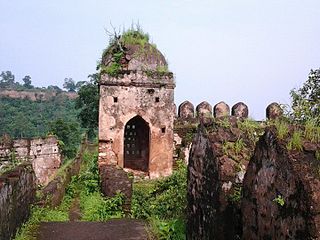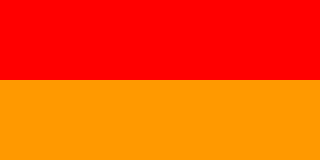
Korea State, currently spelt as Koriya, was a Rajput princely state in the Empire of India. After Indian independence in 1947, the ruler of Korea acceded to the Union of India on 1 January 1948, and Koriya was made part of Surguja District of Central Provinces and Berar province. In January 1950, "Central Provinces and Berar" province was renamed Madhya Pradesh state. After November 2000, Korea and the former princely state of Changbhakar became Koriya district of Chhattisgarh state.
Bhaiyathan is a panchayat village in Surajpur District in the Indian state of Chhattisgarh. Bhaiyathan is part of a community development block under the jurisdiction of Surajpur district and is 23 km away from Surajpur. It is situated on the bank of the Rihand River. Tamor Pingla Wildlife Sanctuary is a major attraction nearby. A famous Devi temple on a hill, Kudargarh, is just 23 km from Bhaiyathan.

Rewa State, also known as Rewah, was a kingdom and later princely state of India, surrounding its eponymous capital, the town of Rewa.

Dhenkanal State was one of the princely states of India during the period of the British Raj. The area of the former state is now referred to as Dhenkanal district, Odisha, with Dhenkanal town as its district headquarters.
Dharamjaygarh is a town and a nagar panchayat in Raigarh District in the state of Chhattisgarh, India. Major languages spoken are Hindi and Chhattisgarhi, with a little Odia, Bengali and English. Laljeet Singh Rathia is a current MLA of the Dharamjaigarh constituency.
Sarangarh is a new district in the Indian state of Chhattisgarh.

Changbhakar State, also known as Chang Bhakar, was one of the small princely states of British Empire in India in the Chhattisgarh States Agency. It included 117 villages and had an area of 2,330 square kilometres (899 sq mi) with a 1941 population of 21,266 people. Bharatpur was the capital of the princely state.

The Palamu kila are two ruined forts located 3 k.m from Betla National Park, Latehar district on the bank of Auranga River, in the Indian state of Jharkhand. The old fort in the plains, which existed even before the Chero dynasty, was built by the King of Raksel dynasty. The original fort in the plains and the other on an adjoining hill are attributed to the kings of the Chero dynasty. The fort in the plains had defences on three sides and three main gates. The New fort was constructed by Raja Medini Ray. East India company used this fort to prison Narayan Peshwa of Tiroha and Raja Harsh dubey alias Subedar Aftab Singh mutineers of 1857.

Bikaner State was the Princely State in the north-western most part of the Rajputana province of imperial British India from 1465 to 1947. The founder of the state Rao Bika was a younger son of Rao Jodha ruler of and founder of the city of Jodhpur in Marwar. Rao Bika chose to establish his own kingdom instead of inheriting his father's. Bika defeated the Jat clans of Jangladesh which today refers to the north and north-western Rajasthan along with his uncle Rao Kandhal and his adviser Vikramji Rajpurohit and founded his own kingdom. Its capital was the city of Bikaner.

The following list includes a brief about the titles of nobility or orders of chivalry used by the Marathas of India and by the Marathis/Konkanis in general.

Raigarh was a princely state in India during the British Raj. The state was ruled by the Gond dynasty of Gond clan.

Gaurihar State was a princely state in India, ruling a territory that is now in Madhya Pradesh.

Kharsawan State, also spelt Kharsua or kharaswan, was a princely state in India during the British Raj. The state had a privy purse of 33,000 rupees. It was one of the Odia Princely states of India during the period of the British Raj and the major language spoken in the area is Odia.

Surguja State was one of the main princely states of Central India during the period of the British Raj, even though it was not entitled to any gun salute. Formerly, it was placed under the Central India Agency, but in 1905 it was transferred to the Eastern States Agency.

Jashpur State was one of the princely states of India during the British Raj. The town of Jashpur was the former state's capital. The rulers were Rajputs of the Chauhan clan.

Kothi State was a princely state of the British Raj. It belonged to the Bagelkhand Agency of Central India. Its capital was at Kothi, in modern Satna district of Madhya Pradesh.















